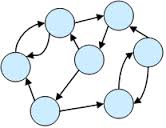Overview
The enum in Java is more powerful than many other languages which can lead to surprising uses.
In this article, I outline some the individual features of enum in Java, and put them together to form a state machine.
Enum for Singleton and Utility class
You can use an enum as a Singleton or Utility very simply.
enum Singleton {
INSTANCE;
}
enum Utility {
; // no instances
}
Enum to implement an interface
You can also implement an interface in an enum.
interface Named {
public String name();
public int order();
}
enum Planets implements Named {
Mercury, Venus, Earth, Mars, Jupiter, Saturn, Uranus, Neptune;
// name() is implemented automagically.
public int order() { return ordinal()+1; }
}
Each Enum Instance a different sub-class
You can override the behaviour of an instance. This effectively give the instance a different sub-class of the enum with its own implementation.
// from http://download.oracle.com/javase/1,5.0/docs/guide/language/enums.html
public enum Operation {
PLUS { double eval(double x, double y) { return x + y; } },
MINUS { double eval(double x, double y) { return x - y; } },
TIMES { double eval(double x, double y) { return x * y; } },
DIVIDE { double eval(double x, double y) { return x / y; } };
// Do arithmetic op represented by this constant
abstract double eval(double x, double y);
}
Using an enum as a state machine
What you can do with all these techniques is to create a enum based statement.

In this short example, a parser state machine processes raw XML from a ByteBuffer. Each state has its own process method and if there is not enough data available, the state machine can return to retrieve more data. Each transition between states is well defined and the code for all states is together in one enum.
interface Context {
ByteBuffer buffer();
State state();
void state(State state);
}
interface State {
/**
* @return true to keep processing, false to read more data.
*/
boolean process(Context context);
}
enum States implements State {
XML {
public boolean process(Context context) {
if (context.buffer().remaining() < 16) return false;
// read header
if(headerComplete)
context.state(States.ROOT);
return true;
}
}, ROOT {
public boolean process(Context context) {
if (context.buffer().remaining() < 8) return false;
// read root tag
if(rootComplete)
context.state(States.IN_ROOT);
return true;
}
}
}
public void process(Context context) {
socket.read(context.buffer());
while(context.state().process(context));
}
写在后面
个人感觉使用如果想真的实现一个完整的finite-state machine的话,上面的例子真的是太基础了。不过参考上面的用法可以帮助我们减少很多的if else if等代码。另外涉及到“分支处理”的情况,在实际的工作中,我更多的还是会选择“策略模式”。